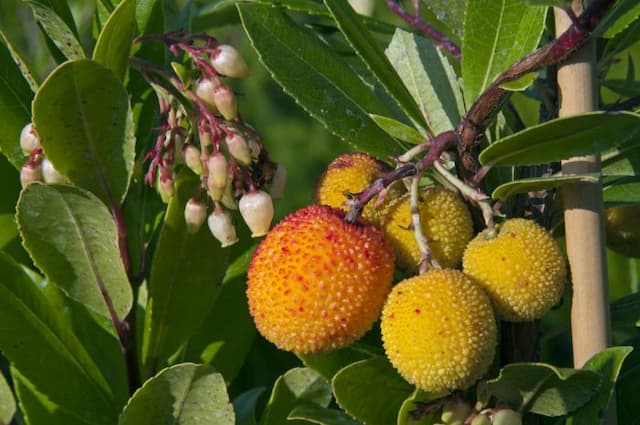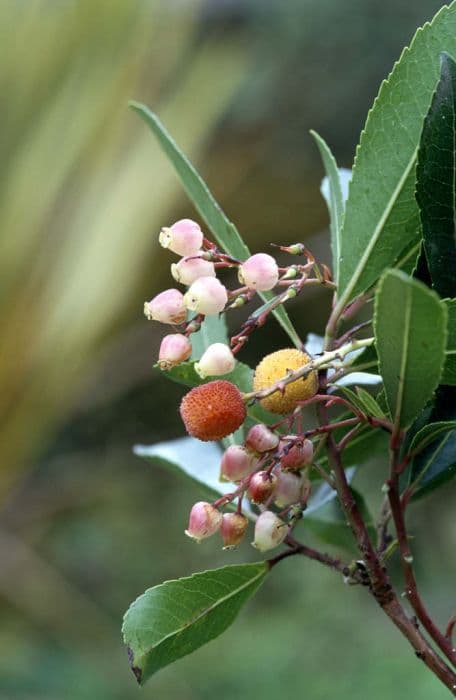Ninepin Heath Erica mammosa red-flowered

ABOUT
The Erica mammosa red-flowered, also known as the Ninepin Heath, is a striking plant that boasts a particularly vibrant and eye-catching appearance. Its most notable characteristic is its profusion of red flowers, which have a bell-shaped form and cluster densely at the tips of the plant's branches. These blossoms create a rich, fiery display that contrasts beautifully against the greenery of the foliage. The leaves of the Ninepin Heath are needle-like, small, and arranged in whorls around the stems, giving the plant a fine, textured look. This detail accentuates the brilliance of the red blossoms. The stems themselves are often a reddish-brown, adding further to the warm tones of the plant's overall aesthetic. In terms of form, the Ninepin Heath has a bushy and well-branched structure, which lends itself to a full and lush appearance. The branches shoot out in various directions, creating a somewhat sprawling and irregular silhouette that adds to its natural charm. Overall, the Ninepin Heath is celebrated for its stunning red flowers—which are undoubtedly the stars of the show—and its fine foliage, which together create a delightful contrast and a visual spectacle in any garden setting where the plant is featured.
About this plant
 Names
NamesFamily
Ericaceae.
Synonyms
Ninepin Heath, Red-flowered Bosruiter.
Common names
Erica mammosa red-flowered.
 Toxicity
ToxicityTo humans
Erica mammosa, commonly known as ninepin heath, is not generally listed as a toxic plant to humans. As such, there are no well-documented symptoms of poisoning from ingesting this particular species. However, since not all plant effects on human health are fully understood, consumption of any part of the ninepin heath plant is not recommended. If ingestion occurs and there is a suspected poisoning, medical attention should be sought.
To pets
In regards to ninepin heath's toxicity to pets, there is limited information available. It is not commonly listed among plants known to be toxic to animals such as dogs and cats. However, as with humans, the absence of known toxicity does not guarantee that a plant is safe. It is generally best to prevent pets from ingesting any part of the ninepin heath since the full extent of its effects is not well-established. If you suspect your pet has ingested part of the plant and is showing signs of distress, contact your veterinarian.
 Characteristics
CharacteristicsLife cycle
Perennials
Foliage type
Evergreen
Color of leaves
Green
Flower color
Red
Height
3 feet [0.91 meters]
Spread
2 feet [0.61 meters]
Plant type
Shrub
Hardiness zones
9
Native area
South Africa
Benefits
 General Benefits
General Benefits- Attracts Pollinators: Erica Mammosa, commonly known as Nine-pin Heath, attracts bees, butterflies, and other beneficial insects essential for pollination.
- Ornamental Value: With its striking red flowers, Nine-pin Heath is often used in gardens and landscapes for its decorative appeal.
- Erosion Control: The shrubby nature and hardy root system of Nine-pin Heath can help stabilize soil and prevent erosion on slopes.
- Habitat for Wildlife: It provides shelter and nesting opportunities for various bird species.
- Drought Tolerance: Adapted to survive with minimal water, making it an excellent plant for xeriscaping and dry gardens.
- Low Maintenance: Once established, it requires minimal care, making it a good choice for gardeners seeking plants that don't require constant attention.
 Medical Properties
Medical PropertiesThis plant is not used for medical purposes.
 Air-purifying Qualities
Air-purifying QualitiesThis plant is not specifically known for air purifying qualities.
 Other Uses
Other Uses- Flower Arranging: The vibrant red flowers of the Erica mammosa make it a popular choice for bouquets and floral arrangements.
- Photography Subject: Gardeners and photographers alike often use the striking appearance of the Erica mammosa for macro photography and nature-inspired art projects.
- Cultural Symbolism: In certain cultures, Erica species may be used during festivals or ceremonies, symbolizing various themes such as beauty or resilience.
- Wildlife Habitat: The dense foliage serves as shelter and the nectar-rich flowers attract pollinators, such as bees and butterflies, helping to support local ecosystems.
- Erosion Control: Planting Erica mammosa on slopes can help prevent soil erosion due to its root system stabilizing the soil.
- Dye Production: Some Erica species can be utilized to create natural dyes for textiles, though this practice is more traditional and less common currently.
- Education and Research: Botanical gardens and educational institutions might use Erica mammosa as a specimen to teach botany and plant ecology.
- Garden Design: Its distinctive red flowers can be used to create color-themed garden sections or to provide winter interest in temperate climates.
- Bonsai: Some Erica species are suitable for creating bonsai, offering an alternative to the traditional species used in this art form.
- Culinary Garnish: While not a common practice, the non-toxic flowers could potentially be used as an ornamental garnish for special culinary presentations.
Interesting Facts
 Feng Shui
Feng ShuiThe plant Erica mammosa is not used in Feng Shui practice.
 Zodiac Sign Compitability
Zodiac Sign CompitabilityThe plant Erica mammosa is not used in astrology practice.
 Plant Symbolism
Plant Symbolism- Endurance and Survival: Erica mammosa, commonly known as the Ninepin Heath, often symbolizes endurance and survival due to its ability to thrive in tough environmental conditions.
- Beauty and Attraction: With its striking red flowers, Ninepin Heath represents beauty and attraction, reminding one of the natural allure found in the wild.
- Solitude: As a plant that can often be found growing alone in its natural habitat, Ninepin Heath may symbolize solitude and the beauty of being independent.
- Protection: In some traditions, heath plants like the Erica mammosa are considered symbols of protection, offering safety amid adversity.
 Water
WaterThe Ninepin Heath, which is the common name for Erica mammosa red-flowered, should be watered regularly to maintain evenly moist soil but it is important to not overwater as this can lead to root rot. During active growth periods in spring and summer, watering may be necessary once or twice a week, depending on climate conditions. Use approximately one gallon of water per week to ensure the soil stays moist but not soggy. In the winter, watering should be reduced to prevent the soil from becoming too wet when the plant is not actively growing.
 Light
LightNinepin Heath thrives best in full sun to partial shade and should receive at least six hours of sunlight daily. It is ideal to place it in a location where it can enjoy the morning sunlight, which is less intense, and get some afternoon shade in hotter climates to protect it from the scorching midday sun.
 Temperature
TemperatureNinepin Heath prefers cool to moderate temperatures, with ideal conditions being between 60°F and 70°F. It can withstand minimum temperatures down to around 30°F, but prolonged exposure to freezing temperatures should be avoided. The maximum temperature tolerated is approximately 80°F, beyond which the plant may experience stress.
 Pruning
PruningPruning Ninepin Heath is necessary to maintain its shape and encourage bushy growth. It should be pruned immediately after flowering finishes, which is usually in the spring. Removing spent flowers and trimming back one-third of the growth will stimulate new growth and ensure the plant stays vibrant and healthy.
 Cleaning
CleaningAs needed
 Soil
SoilThe Ninepin Heath plant prefers acidic soil with a pH range of 4.5 to 5.5. A well-draining, sandy or loamy mix is ideal, incorporating organic matter such as pine bark or peat moss. To achieve optimal growth, ensure the soil is kept moist but not waterlogged.
 Repotting
RepottingNinepin Heath should be repotted every two to three years. It's best done in the spring, before the growing season begins. Use an ericaceous compost mix when repotting to maintain the acidic conditions this plant thrives in.
 Humidity & Misting
Humidity & MistingNinepin Heath flourishes in moderate humidity conditions. Aim for a humidity level of around 40-60%. These plants are tolerant of varying atmospheric moisture levels but avoid placing them in overly dry environments.
 Suitable locations
Suitable locationsIndoor
Keep Ninepin Heath in bright, indirect light indoors.
Outdoor
Place Ninepin Heath in partial shade outdoors.
Hardiness zone
Ninepin Heath is suitable for 7-9 USDA hardiness zones.
 Life cycle
Life cycleErica mammosa red-flowered, commonly known as the Nine-pin Heath, begins its life cycle as a seed, which, after dispersal, will germinate in suitable conditions with well-drained, acidic soil. The seedling emerges and establishes itself, gradually developing into a juvenile plant, forming a woody stem and evergreen needle-like leaves. As the plant matures, it enters the flowering stage, typically blooming in its red-flowered form which is vital for pollination, often by birds or insects. After pollination, the flowers develop into fruits containing seeds, completing the reproductive cycle. These seeds are then released into the environment to find suitable ground to begin the cycle anew. Throughout its life span, the Nine-pin Heath experiences periods of vegetative growth and dormancy, adapting to seasonal changes in its native environment.
 Propogation
PropogationPropogation time
Spring-Early Summer
The Erica mammosa, commonly known as the Nine-pin Heath, can be propagated through seed or vegetative means, but the most popular method is semi-hardwood cuttings. This process typically takes place in late summer to autumn. To propagate using semi-hardwood cuttings, one should select a healthy, disease-free branch and cut a piece about 4 to 6 inches (10 to 15 centimeters) long. The cut end is then dipped in rooting hormone to encourage root growth and planted in a well-draining potting mix. The cutting should be kept in a warm, humid environment, out of direct sunlight, and regularly watered to maintain moisture without becoming waterlogged. With proper care, roots will develop over a period of weeks, after which the new plant can be gradually acclimatized to outdoor conditions and planted in its final location.









